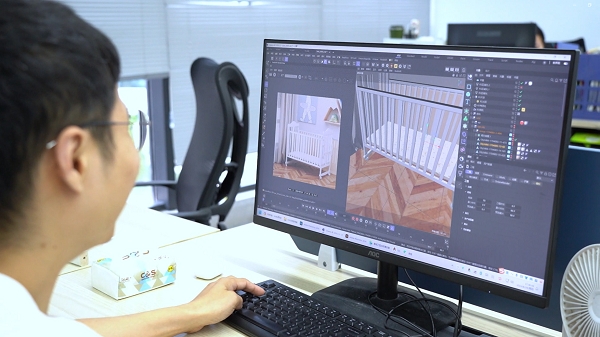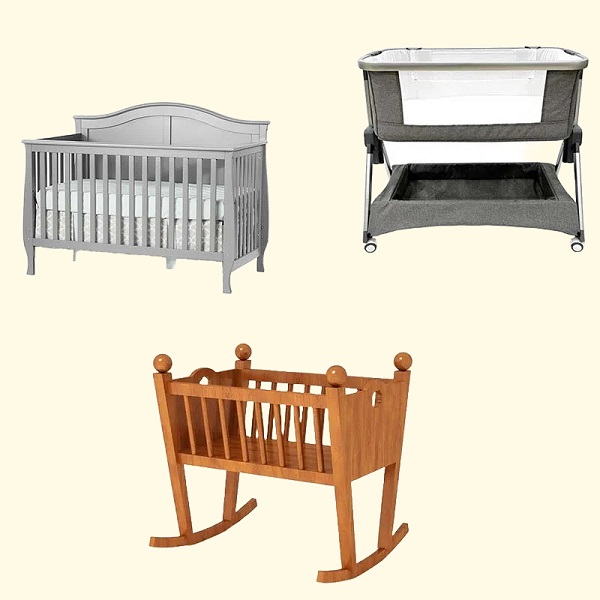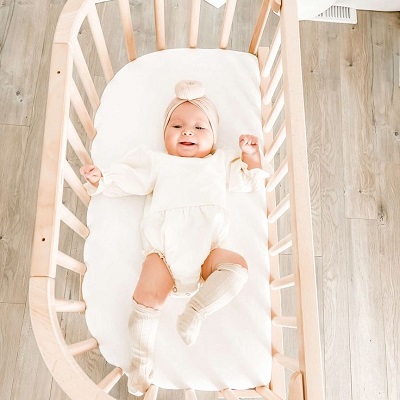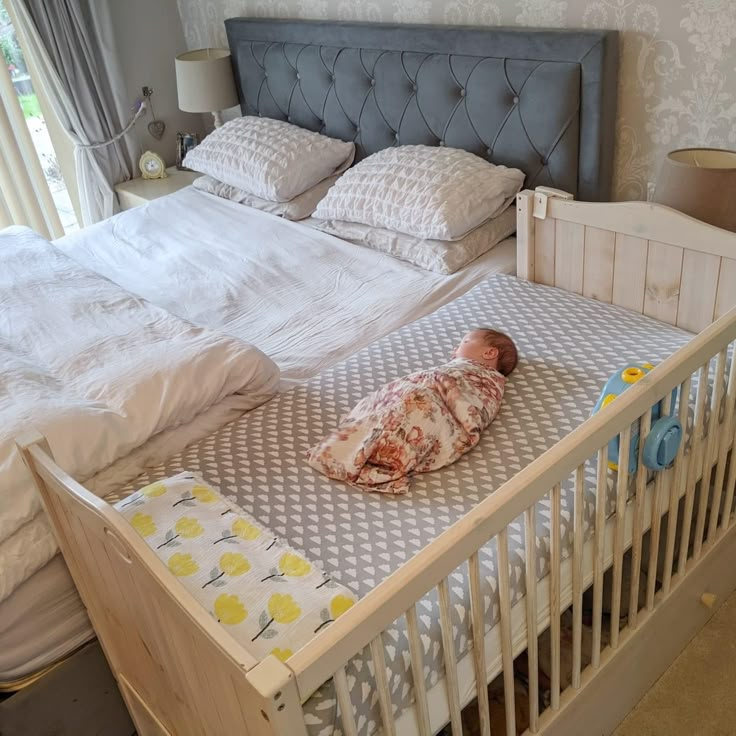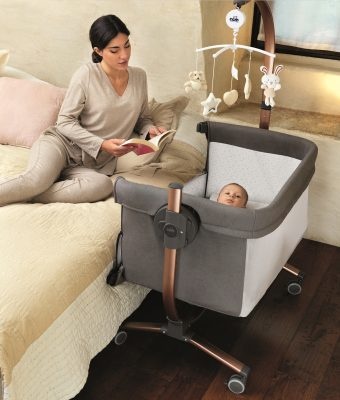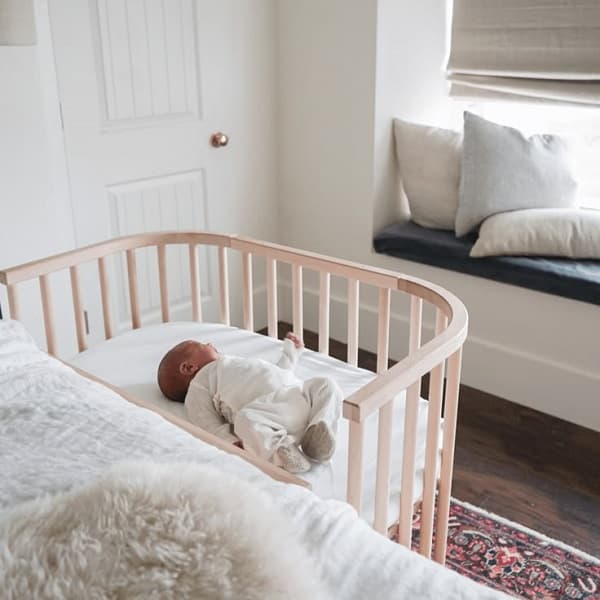You’re putting the final touches on your nursery, but suddenly realize you haven’t picked a sleep space for your baby. What’s the difference between a bassinet and a crib? Do people even use cradles anymore? If your brain is spinning with questions, you’re not alone.
Your baby will spend most of their first year sleeping, and you deserve peace of mind knowing they’re safe. But between Pinterest-perfect nurseries and conflicting advice from your mother-in-law, it’s easy to second-guess every decision.
Are culle just glorified baskets? Do cribs really last until preschool? And why does Grandma keep insisting on that antique cradle?
In this guide, we’ll cut through the noise and compare bassinets, cribs, and cradles head-to-head. No fluff, no jargon—just practical advice to help you make a confident decision that fits your family’s needs.
Bassinet 101: The Basic
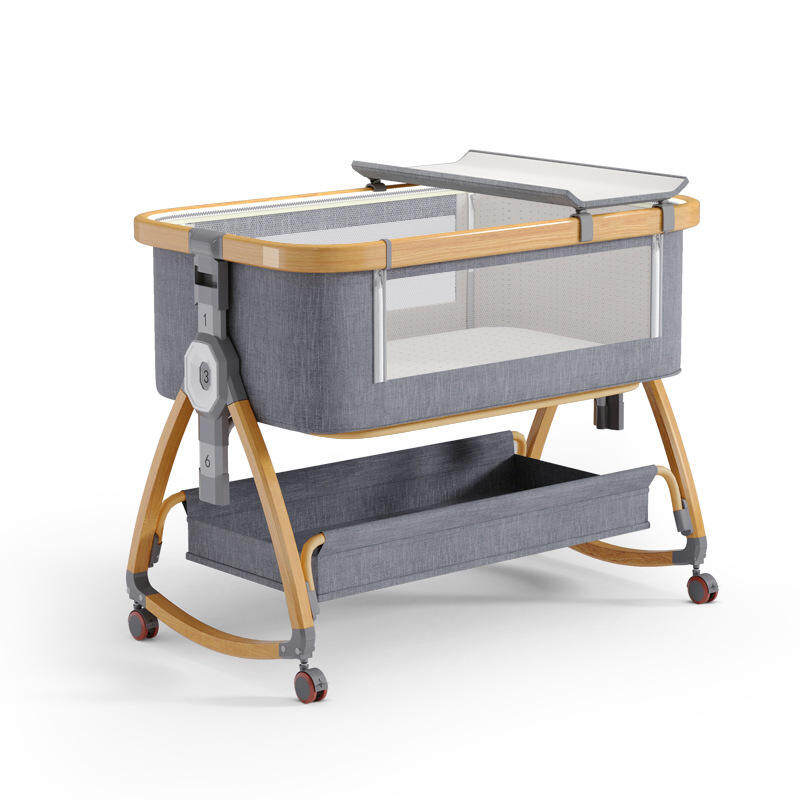
A bassinet is like the cozy “starter home” of baby sleep spaces. Designed for newborns up to 4–6 months (or until your little one starts rolling over), these compact beds prioritize convenience and closeness. Most models feature lightweight frames, breathable mesh sides, and portable designs that let you keep your baby nearby—whether in your bedroom, living room, or even a hotel.
Their primary purpose? To keep your newborn within arm’s reach during those fragile early months while adhering to pediatric safe-sleep guidelines.
Caratteristiche principali
Most bassinets are about the size of a large laundry basket (30” long x 18” wide)—just enough room for a swaddled newborn but snug enough to mimic the coziness of the womb. Significant features such as wheels, lightweight frame, and collapsible designs make it easy to carry and move.
Some rock gently, like the old-school cradle your grandma might rave about, while others have practical perks like storage pockets or built-in nightlights. Some models have drop-down sides for midnight feedings without leaving your bed.
The Pros
The biggest advantage of a bassinet is its ability to simplify those early months. Models with bedside access let you feed your baby without fully waking up, which can mean the difference between a 10-minute feeding and an hour-long ordeal.
The American Academy of Pediatrics (AAP) recommends room-sharing (not bed-sharing) for the first year to reduce SIDS risks, and bassinets make this easier.
They’re also kinder to your wallet than cribs, with prices starting around $50 for basic models.
The Cons
Bassinets have an expiration date. By 5 months, most babies hit the weight limit (usually 15–20 lbs) or start rolling, which means it’s time to upgrade. For larger infants, this window shrinks even further.
Crib 101: The Basic
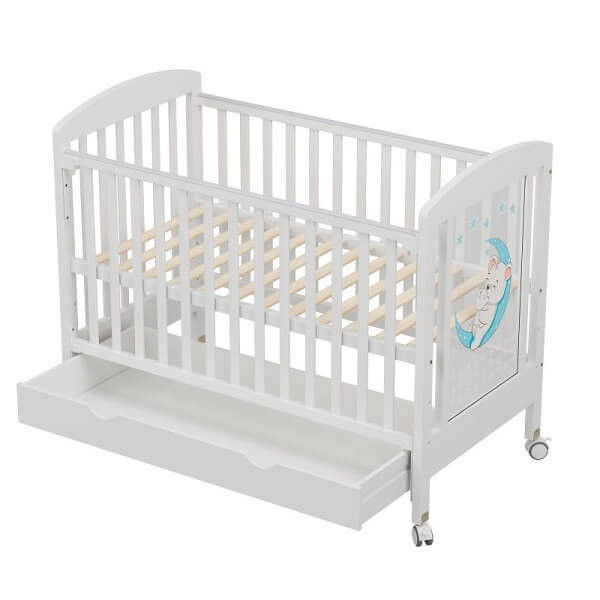
The crib is a workhorse of baby sleep spaces. If the bassinet is your baby’s “starter apartment,” the crib is their forever home—sturdy, reliable, and built to last from those first wobbly nights all the way to the toddler years.
This is where your little one will (hopefully) master rolling over, sitting up, and eventually practicing their jailbreak attempts by shaking the rails.
Caratteristiche principali
Cribs are the SUVs of baby gear—roomy, adaptable, and designed to grow with your child. Most standard cribs measure around 52” long x 28” wide, providing ample space for babies to stretch, roll, and eventually stand, giving even wiggly babies plenty of space.
They come with adjustable mattress heights, so you can lower the bed as your baby becomes a mini Houdini. Convertible models even transform into toddler beds, daybeds, or full-sized frames, stretching their lifespan to years instead of months.
The Pros
Safety-wise, cribs are the gold standard, and they are the only sleep space rigorously tested for structural integrity, stability, and material safety.
The crib is federally regulated and must meet strict ASTM/JPMA certifications—no flimsy parts, no toxic paints, and slats spaced just right to prevent tiny limbs from getting stuck.
The American Academy of Pediatrics (AAP) gives cribs a thumbs-up for safe sleep, as long as you ditch the bumpers, blankets, and stuffed animals.
The Cons
The trade-off? Cribs aren’t exactly portable. Moving one requires a PhD in IKEA-level assembly, and their bulky frames dominate small nurseries. They’re also pricier upfront. And while they can be used from day one, many parents find them too cavernous for newborns.
Cradle 101: The Basic
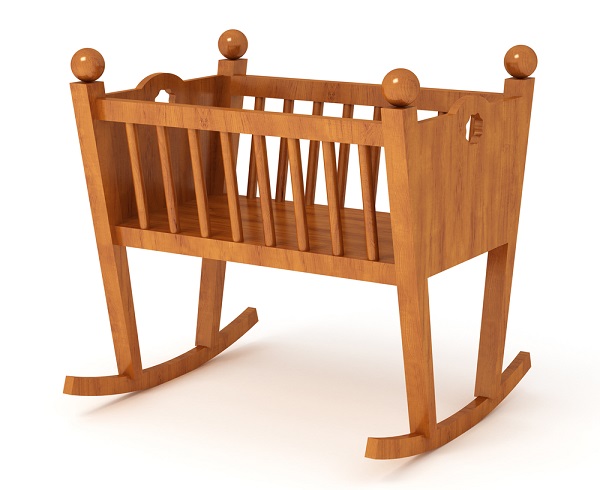
The cradle—the sleep space that whispers grandma’s lullaby and vintage nursery aesthetic. Unlike bassinets or cribs, cradles carry a sentimental appeal, often passed down as family heirlooms or chosen for their vintage aesthetic.
These charming, often rocker-style beds have been around for centuries, but modern parents are wary. While they’re undeniably cozy (picture a wooden rocking cradle with lace trim), they’re also the most debated option on this list.
Caratteristiche principali
Cradles are defined by their compact size, rocking mechanism, and often ornate craftsmanship. Most measure around 30–36 inches long, making them slightly bulkier than bassinets but smaller than cribs.
The classic rocking design—curved rails at the base—allows parents to gently sway the bed manually, mimicking the motion babies felt in the womb. Materials range from solid wood (oak, cherry) to lightweight metals, with finishes that cater to both rustic and contemporary nurseries.
The Pros
The allure of a cradle lies in its soothing motion and sentimental value. The gentle rocking can calm fussy newborns, offering a tactile comfort that static bassinets or cribs can’t replicate. For parents practicing attachment-style parenting, this motion fosters a sense of closeness, especially during daytime naps when supervision is easier.
Aesthetically, cradles shine. They’re statement pieces, blending seamlessly into nurseries with vintage or bohemian themes.
The Cons
Most cradles have shockingly short lifespans—many babies outgrow them by 4 months due to tight weight limits (often 15–20 lbs).
Worse, safety standards for cradles lag behind bassinets and cribs. The older models often fail modern guidelines with deep padding, loose hardware, or unstable rocking bases.
Key Differences: Bassinet Vs Crib Vs Cradle
(The Quick-Reference Cheat Sheet)
| Dimensioni | Culla | Culla | Culla |
| Durata | 0–6 mo | 0–3+ yrs | 0–4 mo |
| Sicurezza | Good | Best | Risky |
| Costo | $ | $$$ | $$ |
| Space | Tiny | Large | Medio |
| Portabilità | Easy | Hard | Moderate |
1. Lifespan: How Long Will It Last?
Bassinet: The sprinter of the group. Perfect for 0–6 months, but most babies outgrow them by the time they start practicing their first roll.
Crib: The marathoner. Built to last from newborn days to toddlerhood (and beyond, if you go convertible).
Cradle: The short-story enthusiast. Designed for 0–4 months, but often retired earlier if your baby hits the 15-lb mark fast.
2. Safety: Which Best Meets Modern Safety Guidelines?
Cribs win here, hands down. They’re federally regulated, tested for durability, and designed with fixed sides to prevent accidents.
Bassinets are safe if they’re JPMA-certified and used correctly (no blankets, no padding). But they’re not held to the same rigorous standards as cribs.
Cradles are the wild card. Many lack modern safety features, and older models can tip or rock too aggressively. The AAP doesn’t explicitly recommend them.
3. Cost: Upfront Price vs Long-Term Value
Bassinet: 50–300. Cheap upfront, but you’ll likely replace it within 6 months.
Crib: 150–1,000+. A splurge initially, but it’ll last years (especially convertible styles).
Cradle: 80–250. Feels affordable, but becomes a pricey decor piece once your baby outgrows it.
4. Space: Who Fits Where?
Bassinet: Fits in a closet (almost). Ideal for studio apartments or bedside setups.
Crib: Demands real estate. Best for dedicated nurseries or spacious rooms.
Cradle: Smaller than a crib but bulkier than a bassinet. Needs room to rock.
5. Convenience: What Makes Life Easier?
Bassinet: Carry it anywhere, collapse it for travel, and reach your baby without leaving bed.
Crib: Stays put. Great for sleep training, but a pain to move or reassemble.
Cradle: Rocking soothes fussy babies, but the motion can be too stimulating for light sleepers.
How to Choose the Right Option for Your Baby?

Let’s cut through the decision fatigue. Ask yourself these four questions:
1. Where Will My Baby Sleep After 6 Months?
If you want a one-and-done solution, invest in a crib (or convertible crib).
If you’re okay with transitioning later, start with a bassinet and switch to a crib when rolling begins.
Skip the cradle unless it’s a short-term supplement (like naps in the living room).
2. How Much Floor Space Can I Spare?
Tiny apartment? Bassinet + mini crib combo.
Dedicated nursery? Standard crib + a bassinet for your bedroom.
Frequent traveler? Portable bassinet + a foldable travel crib.
3. What’s My Budget Really Like?
Under $200: Basic bassinet + a simple crib later.
200–200–500: Convertible crib + a used bassinet.
Splurge-worthy: High-end bassinet + an heirloom crib.
4. Am I a Nervous Nellie or a Laid-Back Parent?
Safety-first types: Skip cradles. Stick with a certified crib and bedside bassinet.
Nostalgic souls: Use a modern, safety-upgraded cradle for supervised naps, but pair it with a crib.
Minimalists: Bassinet until 6 months, then transition straight to a floor bed.
5. The Best Choice for 5 Common Parenting Styles
Simplify decision-making with personality-driven recommendations:
The Minimalist: Skip the cradle; use a bassinet + convertible crib.
The Attachment Parent: Bassinet with breathable mesh walls.
Practical planner: Convertible crib from day one.
The Nomad: Foldable mini culla or travel bassinet.
Vintage lover: Safety-certified cradle + a backup crib.
For grandparents’ houses: A $50 foldable bassinet beats a bulky hand-me-down crib.
FAQs About Bassinets, Cribs, And Cradles
1. When Should I Transition from a Bassinet to a Crib?
Most little ones are ready for a crib between 4–6 months—when they start rolling, pushing up, or hitting the bassinet’s weight limit (usually 15–20 lbs). Pro tip: Transition before they outgrow it to avoid midnight scrambling.
2. Are Cradles Safe for Overnight Sleep?
Cradles shine for supervised daytime naps or calming fussy afternoons. For nighttime? Stick to a crib or bassinet—their sturdier builds and safety certifications are worth the peace of mind.
3. What’s the Best Option for Co-Sleeping Parents?
UN culla da comodino! It keeps your baby inches away without the risks of adult bedding. Look for one that attaches securely to your bedframe—you’ll get the closeness you crave and safer sleep.
4. Do I Need a Bassinet if I Already Have a Crib?
Not required, but here’s why many parents love them: Bassinets keep newborns snug and close during those hazy newborn weeks, making 3 a.m. feedings slightly less zombie-like.
5. What Mattress Should I Use for a Bassinet, Crib, or Cradle?
Stick to these golden rules: Firm, flat, and perfectly fitted. Use the mattress that comes with your bassinet. For cribs, choose ASTM-certified options. Cradles need a firm pad sized exactly to the base—no gaps!
6. How Do I Know if My Bassinet, Crib, or Cradle Is Recalled?
Bookmark the CPSC Recall Database and register your gear when you buy it. Watch for model numbers like “TL345” or date stamps in recall notices.
Conclusione
Choosing between a bassinet, crib, or cradle isn’t about finding the “perfect” solution—it’s about finding what works for your life, your space, and your baby’s safety.
If you take nothing else away: Bassinets are your BFF for the first few months, offering closeness and convenience. Cribs are the undisputed safety champions, built to last through toddlerhood. Cradles? Save them for Instagram-worthy naps, not all-nighters.
Articoli correlati consigliati:

